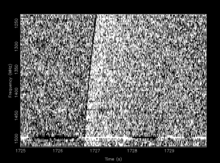Pulsars and neutron stars/Related objects
Introduction
[edit | edit source]There are many objects that (probably) are not directly related to pulsars and yet are either found in pulsar surveys (such as the Fast Radio Bursts; FRBs) or have some similarities (such as the pulsing brown dwarfs) and, hence, are studied by pulsar astronomers.
Fast radio bursts
[edit | edit source]
Fast radio bursts (FRBs) were first discovered by Lorimer et al. (2007). They are very bright (~Jy peak flux densities) short (millisecond-duration) single pulses with dispersion measures that seem to place the source outside of the Galaxy. A recent reprocessing of the initial discovery (stored in the file SMC021_00861) is shown in the Figure. The x-axis is simply time. The y-axis is the observing frequency and the grey-sale represents the intensity of the signal. Note that this data set is recorded with 1-bit sampling and so the signal is either black (above a threshold) or white (below the threshold). The horizontal line around 1500 MHz is an RFI signal. The FRB is the curve that goes from the bottom to the top of the plot. The "white" region after the pulse is caused by the level setting procedure used to ensure that the 1-bit digitiser does not saturate.
Subsequent discoveries have been described in Thornton et al. (2013), Burke-Spolaor & Bannister (2014) and Spitler et al. (2014).
The following table (based initially on this page) lists the currently known FRBs
| Name | Dispersion measure (cm-3pc) |
R.A. | Dec. | UTC | Telescope | Year | Reference |
|---|---|---|---|---|---|---|---|
| 010621 | 746 | 18:52 | -08:29 | 13:02:10.795 | Parkes | 2011 | [1] |
| 010724 | 375 | 01:18 | -75:12 | 19:50:01.630 | Parkes | 2007 | [2] |
| 010125 | 790 | 19:06 | -40:37 | 00:29:13.230 | Parkes | 2014 | [3] |
| 110220 | 944 | 22:34 | -12:24 | 01:55:48.957 | Parkes | 2013 | [4] |
| 110627 | 723 | 21:03 | -44:44 | 21:33:17.474 | Parkes | 2013 | [5] |
| 110703 | 1104 | 23:30 | -02:52 | 18:59:40.591 | Parkes | 2013 | [6] |
| 120127 | 553 | 23:15 | -18:25 | 08:11:21.723 | Parkes | 2013 | [7] |
| 121002 | 1629 | 18:14 | -85:11 | 13:09:18.402 | Parkes | 2013 | [8] |
| 121102 | 557 | 05:32 | +33:05 | 06:35:53.243 | Arecibo | 2014 | [9] |
| 131104 | 779 | 06:44 | -51:16 | 18:04:01.200 | Parkes | 2014 | [10] |
| 140514 | 562 | 22:34 | -12:18 | 17:14:11.06 | Parkes | 2014 | [11] |
Some models of FRBs originating in our Galaxy do exist (GIVE REFs), but most theoretical work has concentrated on extragalactic sources (GIVE REFS).
The peryton story
[edit | edit source]Burke-Spolaor et al. (2011) described a source similar in (some) characteristics to an FRB, but seemed to have a terrestrial origin. These were termed perytons. These have since been shown to be caused by a microwave at the Parkes site.

Ultra-cool dwarfs
[edit | edit source]Some ultra-cool dwarf stars are observed to have strong radio flares that can be periodic. Hallinan et al. (2006) studied TVLM 513-46546 and found persistent, period radio emission with a period of ~2 hours which agrees with the estimates of the rotational period of the dwarf. The radio emission indicates a high brightness temperature and exhibits circular polarization. They conclude that the radiation is likely to be coherent, electron cyclotron maser emission from above the magnetic poles.